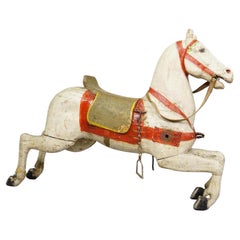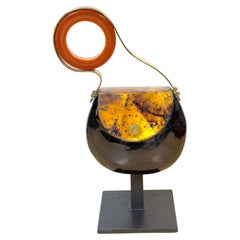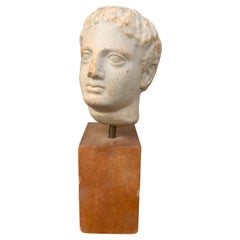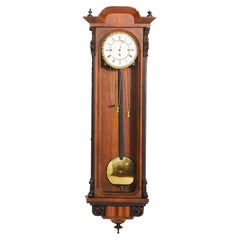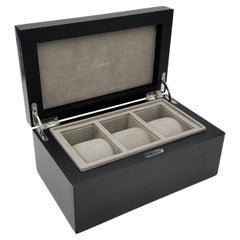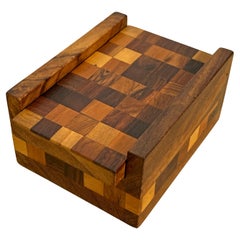Wood Decorative Objects
Late 19th Century German Other Antique Wood Decorative Objects
Wood
20th Century Italian Modern Wood Decorative Objects
Iron
Mid-20th Century American Grand Tour Wood Decorative Objects
Plaster, Wood
1830s European Antique Wood Decorative Objects
Brass
21st Century and Contemporary French Art Deco Wood Decorative Objects
Steel, Chrome
1960s Mexican Mid-Century Modern Vintage Wood Decorative Objects
Jacaranda, Rosewood, Cocobolo
21st Century and Contemporary Peruvian Wood Decorative Objects
Stone, Onyx
Late 20th Century Modern Wood Decorative Objects
Composition
Mid-20th Century Mid-Century Modern Wood Decorative Objects
Wood
19th Century French French Provincial Antique Wood Decorative Objects
Brass, Enamel
Late 20th Century Korean Campaign Wood Decorative Objects
Metal
Late 19th Century Swiss Black Forest Antique Wood Decorative Objects
Nutwood
Mid-19th Century English Gothic Revival Antique Wood Decorative Objects
Oak
1960s French Mid-Century Modern Vintage Wood Decorative Objects
Ceramic, Teak
Early 2000s Irish Modern Wood Decorative Objects
Mahogany, Walnut
Late 19th Century Austrian Black Forest Antique Wood Decorative Objects
Blown Glass, Softwood
19th Century Indian Anglo-Indian Antique Wood Decorative Objects
Mother-of-Pearl, Wood
Late 20th Century Danish Scandinavian Modern Wood Decorative Objects
Wood
Late 20th Century Wood Decorative Objects
Brass
1960s Swedish Gustavian Vintage Wood Decorative Objects
Wood
2010s Italian Wood Decorative Objects
Leather, Wood, Textile
18th Century Italian Rococo Antique Wood Decorative Objects
Agate, Coral
1970s Italian Mid-Century Modern Vintage Wood Decorative Objects
Nickel
18th Century Italian Rococo Antique Wood Decorative Objects
Gold Leaf
20th Century Philippine Mid-Century Modern Wood Decorative Objects
Shagreen, Wood
2010s American Organic Modern Wood Decorative Objects
Steel
Mid-20th Century English Art Deco Wood Decorative Objects
Chrome
1970s European Space Age Vintage Wood Decorative Objects
Glass, Mirror, Wood
1960s Danish Scandinavian Modern Vintage Wood Decorative Objects
Wood, Leather, Teak
Late 20th Century Wood Decorative Objects
Brass
Early 20th Century European Gothic Wood Decorative Objects
Mirror, Wood
Mid-20th Century Spanish Moorish Wood Decorative Objects
Fruitwood
Early 19th Century Japanese Chinoiserie Antique Wood Decorative Objects
Bone, Wood, Lacquer
Early 20th Century Japanese Meiji Wood Decorative Objects
Copper
Late 19th Century British Late Victorian Antique Wood Decorative Objects
Hardwood
1830s British William IV Antique Wood Decorative Objects
Hardwood, Satinwood
1960s American American Craftsman Vintage Wood Decorative Objects
Brass
Early 20th Century Industrial Wood Decorative Objects
Maple
Mid-20th Century Chinese Chinese Export Wood Decorative Objects
Porcelain, Wood, Paint
21st Century and Contemporary Philippine Art Deco Wood Decorative Objects
Oak, Fiberglass
1950s Vintage Wood Decorative Objects
Wood, Maple
1920s Vintage Wood Decorative Objects
Glass, Mahogany
2010s Mexican Mid-Century Modern Wood Decorative Objects
Hardwood
1980s Swiss Modern Vintage Wood Decorative Objects
Wood
1950s Indian Art Deco Vintage Wood Decorative Objects
Ebony, Bone
20th Century Italian Mid-Century Modern Wood Decorative Objects
Marble
Late 19th Century Austrian Antique Wood Decorative Objects
Brass
Early 20th Century British Edwardian Wood Decorative Objects
Brass, Nickel
Early 20th Century French Art Nouveau Wood Decorative Objects
Copper
19th Century American Adirondack Antique Wood Decorative Objects
Oak
Early 19th Century Early Victorian Antique Wood Decorative Objects
Brass
1990s Wood Decorative Objects
Brass
Mid-19th Century English Campaign Antique Wood Decorative Objects
Brass
1940s Spanish Bauhaus Vintage Wood Decorative Objects
Wood
1990s Turkish Art Deco Wood Decorative Objects
Acrylic, Wood, Fruitwood, Driftwood, Pine, Bog Wood
Late 20th Century Wood Decorative Objects
Brass, Stainless Steel
Early 20th Century English Wood Decorative Objects
Abalone, Mother-of-Pearl, Wood
1960s American Mid-Century Modern Vintage Wood Decorative Objects
Stainless Steel
21st Century and Contemporary Italian Modern Wood Decorative Objects
Ebony
2010s Italian Modern Wood Decorative Objects
Leather, Wood, Foam, Walnut
Read More
How a Craving for Color Revolutionized Glass
After synthetic dyes changed fashion, home goods and printed matter, it was only a matter of time till glass caught up.
Kazuyo Sejima’s Flowering Tree Blooms Year-Round
The brilliantly simple design turns a modest bouquet into a major statement.
He Wrote ‘Oedipus Rex,’ but Do You Know What He Looked Like?
The Greek tragedian is said to have been handsome in his day.
Cigar Culture Was Once the Peak of Masculinity. Now, It’s a Compelling Curiosity
Even for those who don’t indulge, elegant smoking accessories and audacious art portraying cigar enthusiasts hold a nostalgic allure.
African Travel Plans on Hold? This Ardmore Leopard Vase Brings the Beauty of the Savanna to You
It’s an excellent example of the sought-after ceramics coming out of South Africa’s KwaZulu-Natal province.
With a High-Tech Flagship and Cool Collabs, Lladró Is Breaking the Mold for Porcelain Production
Thanks to its new leadership, the Spanish maker of figurines, busts and lighting is on a mission to update the art of porcelain for the 21st century.
Zoë Powell’s Magnolia 05 Vessel Is Handmade from Clay She Unearthed Herself
The free-form stoneware piece is inspired by the magnolia tree and its associations with home.
8 Ways to Breathe New Life into a Space with Plants
The pair behind the Instagram account @houseplantclub share their tips for making any room of the house gloriously green.
